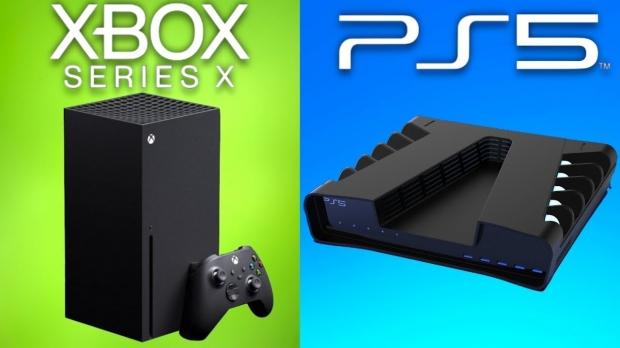thicc_girls_are_teh_best
Gold Member

So we knew this would happen; both companies have revealed their specs, and the spin machines are in full force. Now, I'm by no means a tech expert, but I've tried researching as much into things as I can, if you go by a lot of my posts here. And I paid close attention to MS and Sony's reveals to spot any fudgings.
MS already tried this with the "25 TF" thing getting steam (granted it was more due to the way they explained it, but in general no, XSX doesn't have equivalent of 25 general-purpose TFs), but it seems Sony has created an environment where many are trying something similar with their SSD. Yes in raw measurement terms their SSD is over 2x faster, but people seem to think this will make up for other areas XSX has an advantage in, and that is mostly false. In some aspects it will help, but there are inherent limits to NAND technology and how it works, it is NOT a replacement for volatile RAM or compute horsepower! All the same, those things are not a replacement for non-volatile NAND storage so there's only so much XSX can do to close that given performance gap with PS5.
I'm gonna break down this stuff to the best of my ability and give my reasons why this should be VERY exciting for everyone. (Also when I refer to compute I mean game-orientated compute, not raw data compute. And I only speak FP32 figures here; however you can scale anything to Int 16, Int 8, Int 4 etc)
CPU: 3.6 GHz/3.8 GHz (no SMT) (locked) > up to 3.5 GHz (variable; GPU load could drop the clock down. Taking Cerny's 2% clock drop claim, CPU could dip as low as 3.43 GHz, but there's a possibility it could drop slightly lower if real-world flux results in such)
RAW GPU: 12.147 TF (locked) > up to 10.275 TF (variable; could reach 10.07 TF going by Cerny's comment but it could go lower than that in real-world performance depending on CPU and other I/O power load needs) = 1.872 TF differential (potentially 2.007 TF differential, possibly more depending on if GPU clock dips lower than 2% from max cap)
GPU CU count: 52 CUs > 36 CUs (XSX can perform bigger batches of unique compute calculations on data at any given time while PS5 is limited to smaller batches of unique compute calculations on data at any given time)
GPU Clock: 2.23 GHz > 1.825 GHz (Even if it drops to Cerny's implied 2.185 GHz, it still remains faster. Means PS5 can run through compute calculations up to 405 MHz faster than XSX's GPU, even if XSX can compute more calculations per cycle)
RAY-TRACING (forgot to post this before): 380 billion intersections > 321.441 billion intersections (XSX has larger overall RT performance but it's wider spread out over more CUs, or 7.3 billion intersections per CU. PS5's is lower RT performance but spread out narrower over lesser CUs, or 8.9 billion intersections per CU. XSX's favors wide & slow, PS5's favors narrow & fast)
VRAM: 10 GB 560 GB/s GDDR6 ~> 14 GB - 15.5 GB (see NX Gamer video embedded below) 448 GB/s GDDR6 (in terms of raw numbers that's 5.6 trillion bytes of data per second vs 6.272 trillion bytes of data per second, but the XSX can refresh on its pool over 100 GB/s faster than the PS5 can. AKA PS5 = narrow & fast, XSX = wide and slow)(also takes into consideration PS4 will likely partition at least 2 GB of its RAM for the OS and related system features like multi Quick Resume, similar to XSX)
"GP (general purpose)" RAM: 3.5 GB 336 GB/s GDDR6 ~< 14 GB - 15.5 GB (see NX Gamer video embedded below) 448 GB/s GDDR6 (PS5's bandwidth is faster here, but MS have added some ECC features to their GDDR6 IIRC (something to that effect was mentioned on Monday) and unknown if PS5 has these customizations. Also PS5's 14 GB of usable RAM will be shared between graphics and non-graphics loads, aka 3.5 GB for non-graphics game code is not guaranteed)
OS RAM: 2.5 GB 336 GB/s GDDR6 ~= 500 MB - 2 GB (see NX Gamer video embedded below) 448 GB/s GDDR6 (XSX takes 'wide and slow' approach while PS5 takes 'narrow and fast'. XSX's can hold more unique data at any given time but operates on it over 100 GB/s slower, PS5's holds less unique data at any given time but can operate on it over 100 GB/s faster)
AUDIO: PS5 ~> XSX (This one we don't actually know too much on regarding XSX or even PS5, but for now I'd probably give PS5 the edge. The question however is if its audio engine has its own pool of RAM; it very likely doesn't, meaning it's sharing from the 14 GB the system probably has set aside for games)
SSD: 5.5 GB/s > 2.4 GB/s (This is the clearest advantage PS5 has over XSX. Its drive is over 2x faster on both raw and compressed data. It also seems to have more dedicated decompression ASIC hardware built into the flash memory controller, and might have more granularity in the number of privilege levels and memory channels. While open-market 3rd-party drives have to be approved by Sony for 3rd parties (versus Microsoft going with a proprietary format currently only partnered with Seagate), BOTH systems will have expansion bays for additional fast storage, as well as a slower USB-style port for external drives where PS5/XSX games can be stored but not played from (only previous-gen games will be playable from storage devices connected to the USB ports)
(*EDIT: So uhm, there might potentially be some confusion on the PS5 side of things here. Eurogamer says PS5's expandable storage solution is with (essentially) external drives primarily aimed with storage in mind, similar to XSX's approach with using external HDDs through one of the USB ports (where pre-XSX games can run off of, but not XSX games).
HOWEVER, it seems (again according to Eurogamer's report) that in order to expand PS5's internal storage while having performance similar to the internal drives, you'll have to replace the 825 GB internal drive with a compatible 7 GB/s PCIe 4.0-complaint, Sony-approved 3rd-party off-the-shelf drive.* )
So in reality, we're looking at 1x custom 5.5 GB/s drive in PS5 and 2x 2.4 GB/s drives (4.8 GB/s total) drives for XSX. The only question around XSX's setup is if both drive bays can be read from simultaneously. If so, while games could only specifically target a single SSD's worth of performance at finer low-level access, the XSX OS could provide boosted performance for a game if an expansion drive is detected in the back card port. Combined performance would still be slower than PS5's replaceable internal custom drive, but the gap would be much smaller.
Also worth keeping in mind that since both systems are memory-mapping giant portions of their SSDs as v-cache for the GPUs, this influences the GPU clock speed rates. AKA the GPUs will not just be reading data from the GDDR6 RAM)
--------
So in the end, I think that sums up the unique strengths and weaknesses with each approach. We really aren't looking at a situation where one system has a flush advantage over the other in every single category, and the divergent approaches they've taken is actually really refreshing. Most of us thought we'd be looking at twin boxes this gen with the only difference being OS features and 1st party content, but this is actually a lot more in spirit to 7th-gen and earlier generations.
For those of us who get a kick out of reading up on the esoteric designs of consoles past, PS5 and XSX almost feel like a return to that...within reason. They bring the best of a homogenized tech space we have today, but have very clear design philosophies that implement their tech in pretty different ways that feel close spiritually to the heyday of exotic console architectures. I'm talking those SNES/MegaDrive, PS1/Saturn/N64, PS2/DC/GC/Xbox days even!
Sure it's not QUITE like it was then, but any divergences MS and Sony could've taken to offer unique approaches to next-gen while still meeting their respective performance targets, in the modern era, is well and fine by me. And going by what devs have been saying, it's fine by them, too. Of course, you will have devs who prefer the PS5's approach, and you will have devs who prefer the XSX's approach, and that is always reflective of a mix of skill + personal taste. But it's going to be really fun to see what unique game design philosophies emerge from these two systems, and for that I say everyone wins here!
BONUS!!!
NX Gamer just put out this excellent video analyzing the differences between the two systems. Really, really top-class stuff. Dude is very fair and has some surprising perspectives on the systems and clarifies a lot of misconceptions on both systems right now. Even made me reconsider the GPU clock thing; seems like the maximum dip in PS5 GPU really will be only around 2% or so as Cerny said.
He also puts the SSD in better perspective and that might help folks contextualize why developers seem very excited for it. He also mentions that the split pool in XSX might potentially be a small bottleneck, but nothing that will cause any big problems. He's very excited about the differences in the two systems and what that'll mean for developers.
Easily one of the best early analysis videos on comparing the two systems, strongly suggest you all give it a watch!
Last edited:


